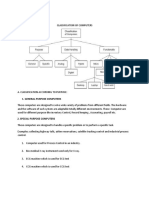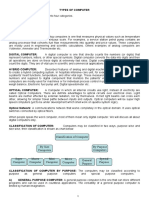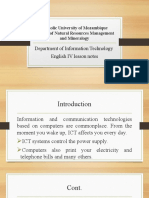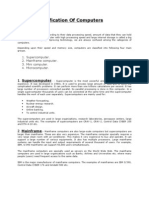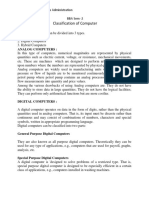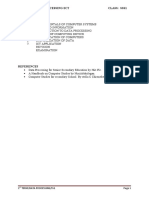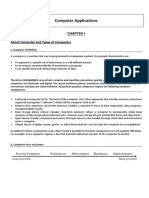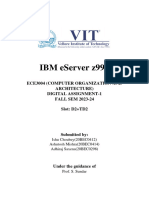OHS, Tools, Materials, Equipment
Quarter 1
COC 1: Install and Configure Computer
Systems
�Types of Computers
�At the end of topic, student will be able to:
1. Identify the types of computers
2. Classify the computers according to its
function and uses
3. Appreciate the benefits of computers in
their daily lives.
�1. Super Computer
- The most powerful computers regarding
performance and data processing.
- these are specialized computers used by
large corporations
- task specific computers
�1. Super Computer
- can do millions of math operations in one
second
- called the “math crunchers”
- has thousands of processors
- hundreds of gigabytes of RAM
- hundreds of gigabyte of storage space
��Super computer, where it is being used?
✓ for research
✓ for space exploration
✓ for earthquake studies
✓ for weather forecasting
✓ for nuclear power testing
✓ for government systems
���2. Mainframe computers
- Mainframes are data servers that are
designed to process up to 1 trillion web
transactions daily with the highest levels of
security and reliability.
�2. Mainframe computers
- are high-performance computers with
large amounts of memory and data
processors that process billions of simple
calculations and transactions in real-time.
�2. Mainframe computers
- A mainframe computer is critical to
commercial databases, transaction servers
and applications that require high resiliency,
security and agility.
�2. Mainframe computers
- Since the advent of the internet and the
rise of cloud computing, some may think of
the mainframe as a tech dinosaur.
�2. Mainframe computers
- Mainframe is a very large and expensive
computer capable of supporting hundreds, or
even thousands, of users
simultaneously.
�� Mainframe computer - Where it is being
used?
✓ for Telephone companies – telephone calls
✓ for TV network – send shows to millions of homes
✓ for Transportation Department – for traffic
signals, railroad and subway
✓ for Bank – keeps track of money flow
� Mainframe computer - Where it is being
used?
✓ for Supermarkets – keep track of their products
and prices
✓ for huge companies or employers that organize
their worker’s record
✓ for Electric company – keep track on their
customers electric consumption, bills, payment
���3. Mini Computers
- Often referred to as Midrange Machines
- they are smaller, less powerful, and more
affordable than mainframe computer
- capable of supporting multiple users
simultaneously
�3. Mini Computers
- smaller than mainframe computer but
larger than microcomputers
- capable of handling a variety of tasks,
including data processing, scientific
calculations, and business applications
������4. Micro Computer
-That utilizes a microprocessor as its central
control and arithmetic element
- primarily designed for use by a single
person at a time
�4. Micro Computer
- specially designed for general usage like
entertainment, education, and work
purposes.
�4. Micro Computer
- Examples:
- desktop computers or personal computers
- gaming consoles
- sounds and navigation system of a car
- Netbook
- Notebook
�4. Micro Computer
- Examples:
- PDAs
- Tablet PC’s
- Smartphones
- Calculators
�1773: First Functional Calculator
�1820: First
Commercially
Produced
Mechanical
Calculator
�1954: First All-
Transistor
Calculator
�1961: First
All-Electronic
Desktop
Calculator
�1967: First
Handheld
Calculator
�1971: First Truly
Pocket-Sized
Electronic
Calculator to
use LED Display
�1974: First
Handheld
Programmable
Calculator
�1985: First
Graphing
Calculator
�2003: First
Graphing
Calculator with
Touch
Functionality
�2010: First
Color
Graphing
Calculator










